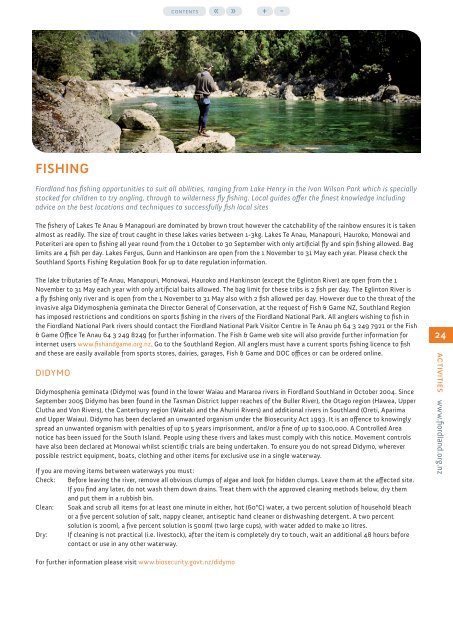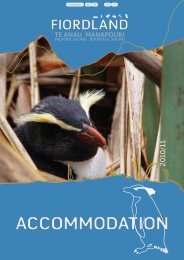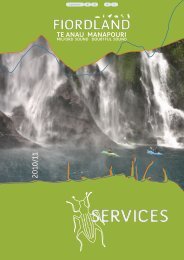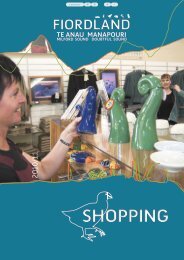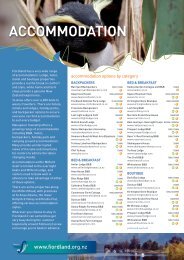Fiordland Activities (11.3 MB) - Southern Lakes
Fiordland Activities (11.3 MB) - Southern Lakes
Fiordland Activities (11.3 MB) - Southern Lakes
You also want an ePaper? Increase the reach of your titles
YUMPU automatically turns print PDFs into web optimized ePapers that Google loves.
fishing<br />
<strong>Fiordland</strong> has fishing opportunities to suit all abilities, ranging from Lake Henry in the Ivon Wilson Park which is specially<br />
stocked for children to try angling, through to wilderness fly fishing. Local guides offer the finest knowledge including<br />
advice on the best locations and techniques to successfully fish local sites<br />
The fishery of <strong>Lakes</strong> Te Anau & Manapouri are dominated by brown trout however the catchability of the rainbow ensures it is taken<br />
almost as readily. The size of trout caught in these lakes varies between 1-3kg. <strong>Lakes</strong> Te Anau, Manapouri, Hauroko, Monowai and<br />
Poteriteri are open to fishing all year round from the 1 October to 30 September with only artificial fly and spin fishing allowed. Bag<br />
limits are 4 fish per day. <strong>Lakes</strong> Fergus, Gunn and Hankinson are open from the 1 November to 31 May each year. Please check the<br />
Southland Sports Fishing Regulation Book for up to date regulation information.<br />
The lake tributaries of Te Anau, Manapouri, Monowai, Hauroko and Hankinson (except the Eglinton River) are open from the 1<br />
November to 31 May each year with only artificial baits allowed. The bag limit for these tribs is 2 fish per day. The Eglinton River is<br />
a fly fishing only river and is open from the 1 November to 31 May also with 2 fish allowed per day. However due to the threat of the<br />
invasive alga Didymosphenia geminata the Director General of Conservation, at the request of Fish & Game NZ, Southland Region<br />
has imposed restrictions and conditions on sports fishing in the rivers of the <strong>Fiordland</strong> National Park. All anglers wishing to fish in<br />
the <strong>Fiordland</strong> National Park rivers should contact the <strong>Fiordland</strong> National Park Visitor Centre in Te Anau ph 64 3 249 7921 or the Fish<br />
& Game Office Te Anau 64 3 249 8249 for further information. The Fish & Game web site will also provide further information for<br />
internet users www.fishandgame.org.nz. Go to the Southland Region. All anglers must have a current sports fishing licence to fish<br />
and these are easily available from sports stores, dairies, garages, Fish & Game and DOC offices or can be ordered online.<br />
didymo<br />
Didymosphenia geminata (Didymo) was found in the lower Waiau and Mararoa rivers in <strong>Fiordland</strong> Southland in October 2004. Since<br />
September 2005 Didymo has been found in the Tasman District (upper reaches of the Buller River), the Otago region (Hawea, Upper<br />
Clutha and Von Rivers), the Canterbury region (Waitaki and the Ahuriri Rivers) and additional rivers in Southland (Oreti, Aparima<br />
and Upper Waiau). Didymo has been declared an unwanted organism under the Biosecurity Act 1993. It is an offence to knowingly<br />
spread an unwanted organism with penalties of up to 5 years imprisonment, and/or a fine of up to $100,000. A Controlled Area<br />
notice has been issued for the South Island. People using these rivers and lakes must comply with this notice. Movement controls<br />
have also been declared at Monowai whilst scientific trials are being undertaken. To ensure you do not spread Didymo, wherever<br />
possible restrict equipment, boats, clothing and other items for exclusive use in a single waterway.<br />
If you are moving items between waterways you must:<br />
Check: Before leaving the river, remove all obvious clumps of algae and look for hidden clumps. Leave them at the affected site.<br />
If you find any later, do not wash them down drains. Treat them with the approved cleaning methods below, dry them<br />
and put them in a rubbish bin.<br />
Clean: Soak and scrub all items for at least one minute in either, hot (60°C) water, a two percent solution of household bleach<br />
or a five percent solution of salt, nappy cleaner, antiseptic hand cleaner or dishwashing detergent. A two percent<br />
solution is 200ml, a five percent solution is 500ml (two large cups), with water added to make 10 litres.<br />
Dry: If cleaning is not practical (i.e. livestock), after the item is completely dry to touch, wait an additional 48 hours before<br />
contact or use in any other waterway.<br />
24<br />
activities www.fiordland.org.nz<br />
For further information please visit www.biosecurity.govt.nz/didymo


